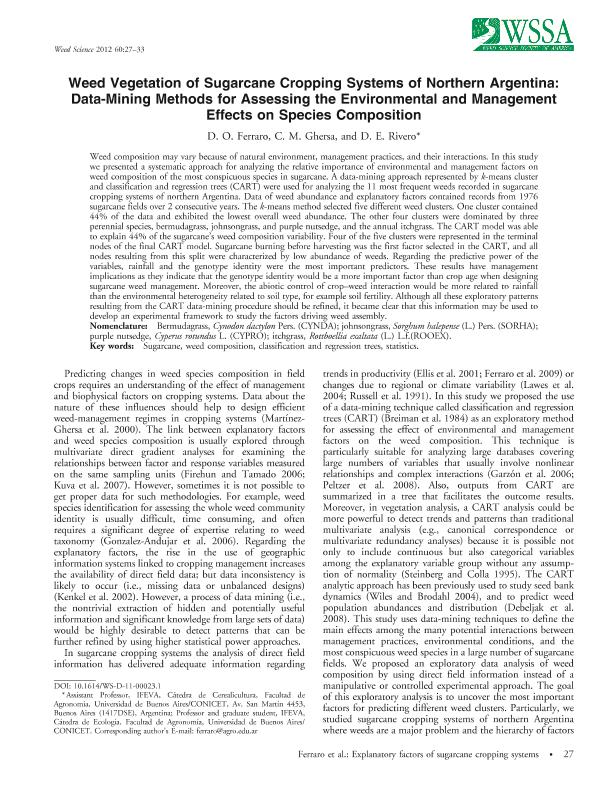Mostrar el registro sencillo del ítem
dc.contributor.author
Ferraro, Diego Omar

dc.contributor.author
Ghersa, Claudio Marco

dc.contributor.author
Rivero, Diego Eduardo

dc.date.available
2018-09-19T19:14:42Z
dc.date.issued
2012-01
dc.identifier.citation
Ferraro, Diego Omar; Ghersa, Claudio Marco; Rivero, Diego Eduardo; Weed vegetation of sugarcane cropping systems of northern argentina: Data-mining methods for assessing the environmental and management effects on species composition; Weed Science Society of America; Weed Science; 60; 1; 1-2012; 27-33
dc.identifier.issn
0043-1745
dc.identifier.uri
http://hdl.handle.net/11336/60291
dc.description.abstract
Weed composition may vary because of natural environment, management practices, and their interactions. In this study we presented a systematic approach for analyzing the relative importance of environmental and management factors on weed composition of the most conspicuous species in sugarcane. A data-mining approach represented by k-means cluster and classification and regression trees (CART) were used for analyzing the 11 most frequent weeds recorded in sugarcane cropping systems of northern Argentina. Data of weed abundance and explanatory factors contained records from 1976 sugarcane fields over 2 consecutive years. The k-means method selected five different weed clusters. One cluster contained 44% of the data and exhibited the lowest overall weed abundance. The other four clusters were dominated by three perennial species, bermudagrass, johnsongrass, and purple nutsedge, and the annual itchgrass. The CART model was able to explain 44% of the sugarcane's weed composition variability. Four of the five clusters were represented in the terminal nodes of the final CART model. Sugarcane burning before harvesting was the first factor selected in the CART, and all nodes resulting from this split were characterized by low abundance of weeds. Regarding the predictive power of the variables, rainfall and the genotype identity were the most important predictors. These results have management implications as they indicate that the genotype identity would be a more important factor than crop age when designing sugarcane weed management. Moreover, the abiotic control of cropweed interaction would be more related to rainfall than the environmental heterogeneity related to soil type, for example soil fertility. Although all these exploratory patterns resulting from the CART data-mining procedure should be refined, it became clear that this information may be used to develop an experimental framework to study the factors driving weed assembly. Nomenclature: Bermudagrass, Cynodon dactylon Pers. (CYNDA); johnsongrass, Sorghum halepense (L.) Pers. (SORHA); purple nutsedge, Cyperus rotundus L. (CYPRO); itchgrass, Rottboellia exaltata (L.) L.f.(ROOEX). © Weed Science Society of America.
dc.format
application/pdf
dc.language.iso
eng
dc.publisher
Weed Science Society of America

dc.rights
info:eu-repo/semantics/openAccess
dc.rights.uri
https://creativecommons.org/licenses/by-nc-sa/2.5/ar/
dc.subject
Classification And Regression Trees
dc.subject
Statistics
dc.subject
Sugarcane
dc.subject
Weed Composition
dc.subject.classification
Agricultura

dc.subject.classification
Agricultura, Silvicultura y Pesca

dc.subject.classification
CIENCIAS AGRÍCOLAS

dc.title
Weed vegetation of sugarcane cropping systems of northern argentina: Data-mining methods for assessing the environmental and management effects on species composition
dc.type
info:eu-repo/semantics/article
dc.type
info:ar-repo/semantics/artículo
dc.type
info:eu-repo/semantics/publishedVersion
dc.date.updated
2018-09-10T16:31:33Z
dc.journal.volume
60
dc.journal.number
1
dc.journal.pagination
27-33
dc.journal.pais
Estados Unidos

dc.journal.ciudad
Laurence
dc.description.fil
Fil: Ferraro, Diego Omar. Consejo Nacional de Investigaciones Científicas y Técnicas. Oficina de Coordinación Administrativa Parque Centenario. Instituto de Investigaciones Fisiológicas y Ecológicas Vinculadas a la Agricultura. Universidad de Buenos Aires. Facultad de Agronomía; Argentina
dc.description.fil
Fil: Ghersa, Claudio Marco. Consejo Nacional de Investigaciones Científicas y Técnicas. Oficina de Coordinación Administrativa Parque Centenario. Instituto de Investigaciones Fisiológicas y Ecológicas Vinculadas a la Agricultura. Universidad de Buenos Aires. Facultad de Agronomía; Argentina
dc.description.fil
Fil: Rivero, Diego Eduardo. Consejo Nacional de Investigaciones Científicas y Técnicas. Oficina de Coordinación Administrativa Parque Centenario. Instituto de Investigaciones Fisiológicas y Ecológicas Vinculadas a la Agricultura. Universidad de Buenos Aires. Facultad de Agronomía; Argentina
dc.journal.title
Weed Science

dc.relation.alternativeid
info:eu-repo/semantics/altIdentifier/doi/https://dx.doi.org/10.1614/WS-D-11-00023.1
dc.relation.alternativeid
info:eu-repo/semantics/altIdentifier/url/https://www.cambridge.org/core/journals/weed-science/article/weed-vegetation-of-sugarcane-cropping-systems-of-northern-argentina-datamining-methods-for-assessing-the-environmental-and-management-effects-on-species-composition/DBEC7F008CDF9048505B3FD78044E8B7
Archivos asociados
